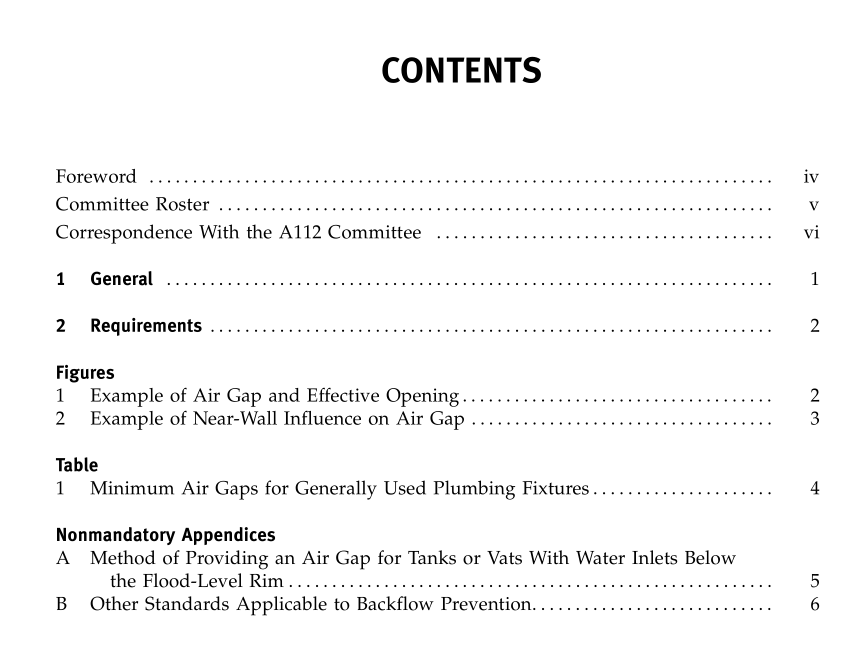ASME A112.1.2:2004 pdf free download Air Gaps in Plumbing Systems (For Plumbing Fixtures and Water-Connected Receptors)
1 GENERAL1.1 Scope
This Standard identifies methods of providing protec-tion against back siphonage through means of an airgap and establishes physical requirements and methodsof testing air gaps for plumbing fixtures and waterreceptors.
1.2 Units of Measurement
Values are stated in U.S.Customary Units and in theInternational System of Units (SI); the U.s. CustomaryUnits shall be considered as the standard.
1.3 Air Gap for Tanks or Vats With Water Inlets
Below the Flood-Level Rim
For those cases where it is not practicable to providea minimum required air gap above the flood-level rim(top edge) of a tank or vat, a suggested substitute proce-dure is given in Nonmandatory Appendix A.
1.4 References
The following documents form a part of this Standardto the extent specified herein. Unless otherwise speci-fied, the latest edition shall apply.
ASME A112.19.5,Trim for Water-Closet Bowls,Tanks,and Urinals1
Publisher: The American Society of Mechanical Engi-neers (ASME International), Three Park Avenue, NewYork, NY 10016-5990; Order Department: 22 LawDrive, Box 2300,Fairfield, NJ 07007-2300
ASSE /ANSI 1011, water-Closet rtusnf Sanitarv Engi-Publisher: The American Society of Sanitary Engi-
neering (ASSE),901 Canterbury Road,Suite A, West-lake, OH 44145
CSA B125,Plumbing Fittings
Publisher: Canadian Standards Association (CSA),5060Spectrum Way,Suite 100,Mississauga, Ontario L4W5N6,Canada
1.5 Definitions
air gap: a vertical distance through the atmospherebetween the lowest potable water outlet and the highestlevel of the source of fluid contamination.
air gap, critical: the air gap that will prevent back siphon-age when tested under laboratory conditions, with stillwater, wide-open control valve, and a vacuum of at least25 in.Hg (635 mm Hg).
air gap, minimum required: an air gap greater than thecritical air gap by a factor of safety to cover serviceconditions.The air gap required to prevent back siphon-age through a water supply opening (faucet or valve),under the action of atmospheric pressure and a vacuumin the water supply system, depends principally on thesize of the effective opening and the distance betweenthe end of the supply fitting outlet (spout) pipe and anearby wall. The minimum required air gap shall bemeasured vertically from the lowest part of the outletof the faucet, spout,or supply pipe to the flood-levelrim of the fixture or receptor (see Figs.1,2, and A-1).backfloww: the flow of water or other liquids into the dis-tributing pipes of a potable supply of water from anysource or sources other than the intended source. Backsiphonage and back pressure are types of backflow.backflow connection or condition: any arrangementwhereby backflow can occur.
backflow prevention device: a device or assembly (combina-tion of devices) designed to prevent backflow.
critical level nmark: the level at which back siphonagewill not occur,including any required factor of safety;a permanent mark on the external surface of the faucetor device that is visible after installation of the faucetor device. When the faucet or device is installed withthe critical level mark at or above the flood-level rim ofa fixture or receptor, this creates the minimum requiredair gap and will prevent back siphonage.
effective opening: the smallest cross-sectional area in afaucet, device, or a supply pipe through which waterflows to an outlet.If two or more lines supply one outlet,the effective opening shall be the sum of the cross-sec-tional areas of the individual lines or the area of theoutlet, whichever is smaller.
NOTE: See Fig. 1 for effective opening. With ordinary plumbingfixtures, the minimum cross-sectional area usually occurs at the seat of the control valve, B; but, in other cases, it may be at the point of discharge (spout) or at the inlet to the control valve, X.
elevation: the air gap–related term applied to drinking fountain nozzles.
flood-level rim: the top edge of the receptor from which water will flow out of the receptor (an overflow opening is not considered a flood-level rim).
ASME A112.1.2:2004 pdf free download
